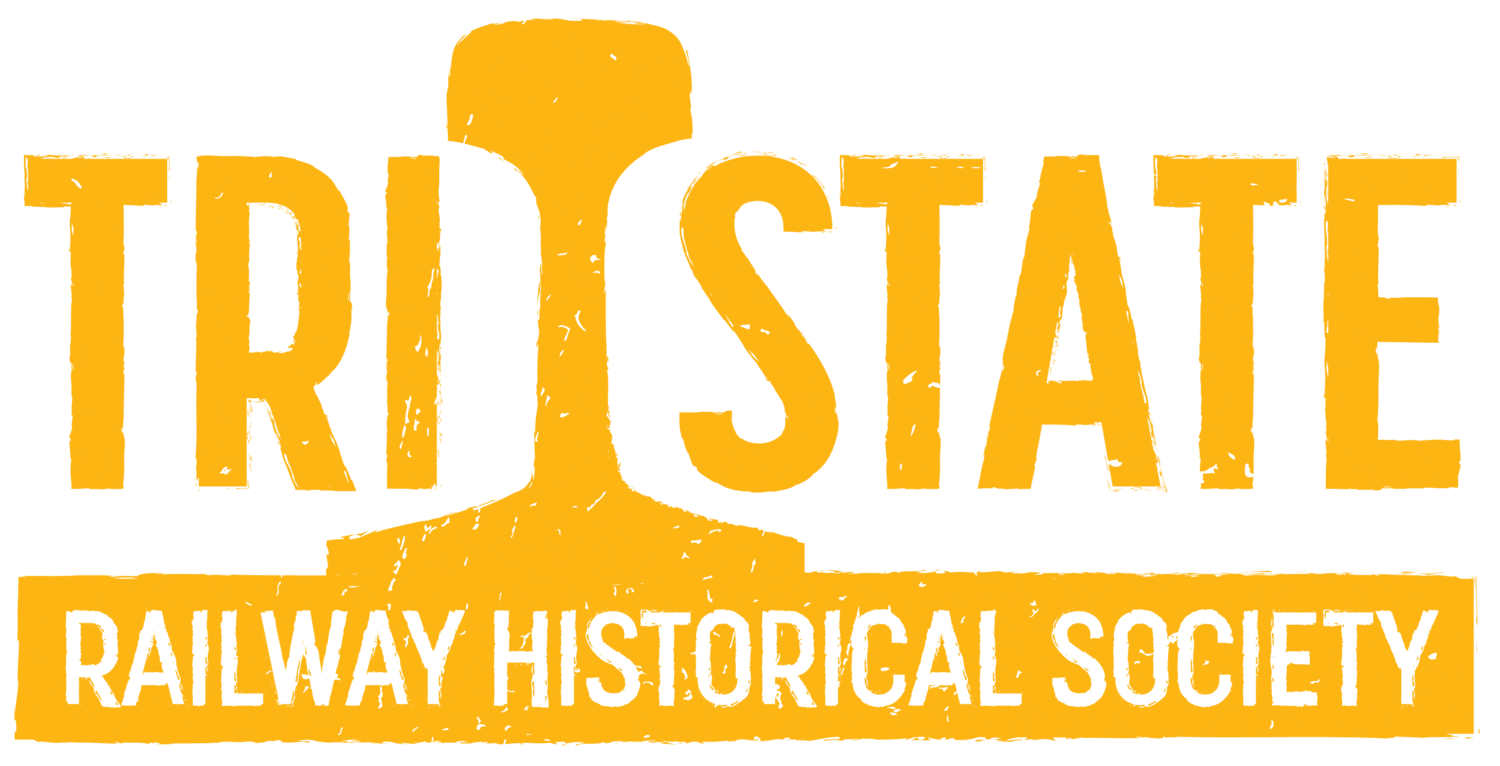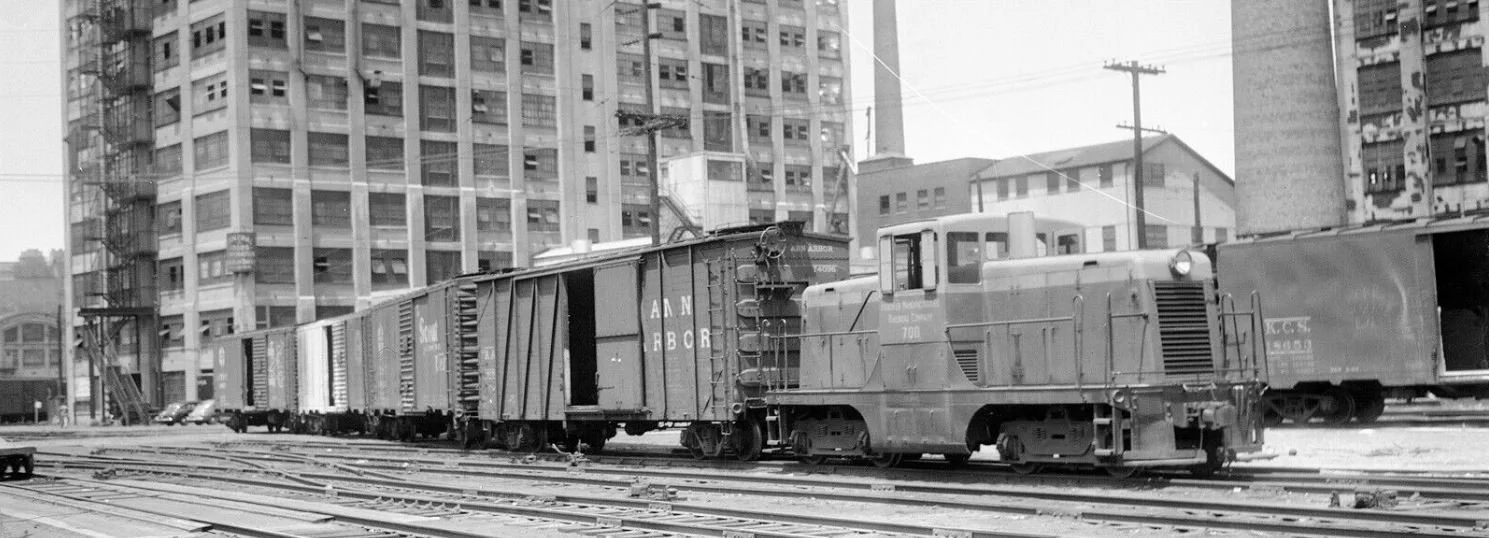HOBOKEN MANUFACTURERS RAILROAd
General Electric 44-ton locomotive #700
Hoboken Manufacturers Railroad No. 700 is the only piece of railroad equipment remaining from this unique New Jersey short-line. The Hoboken Manufacturers Railroad, also known as the Hoboken Shore Road or Hoboken Shore Railroad, was a mile-and-a-half-long, waterfront short-line operated nearly exclusively within the confines of Hoboken, NJ.
The railroad traced its origins to one of New Jersey’s most prominent citizens, Col. John Stevens III (1749-1838). Stevens had acquired the land that today comprises the City of Hoboken in 1784. In addition to being a lawyer, politician, and businessman, he was also an engineer and inventor. He built the first steam locomotive constructed in the United States, which he demonstrated on a circle of track on his estate in Hoboken. He was also the holder of the first charter for a railroad in the country, though it was never built.
Stevens’s descendants were illustrious in their own right. His son, Robert Livingston Stevens (1787-1856), was the President of the Camden & Amboy Rail Road, the first railroad constructed in New Jersey. Another son, Edwin Augustus Stevens (1795-1868), left a directive in his will to establish an institution of higher learning, which became the Stevens Institute of Technology.
Shortly before his death in 1838, Stevens had incorporated the Hoboken Land & Improvement Co. to manage his vast landholdings with his descendants taking charge of the enterprise. In September 1895, the Hoboken Railroad, Warehouse & Steamship Connecting Co. was incorporated as a subsidiary with Edwin’s sons, Edwin A., Jr., Robert L. II, and Richard Stevens, among the incorporators.
Construction of the railroad began in 1896 and the railroad was opened to traffic on September 20, 1897, doing business under the name “Hoboken Shore Road.” The railroad was built as an electric line, using a single overhead wire for its entire 1.4-mile length. A physical connection was made with the Erie Railroad (later Erie Lackawanna) in Weehawken, NJ.
In July 1902, the Hoboken Manufacturers Railroad Company (HMRC) was incorporated to connect the Delaware, Lackawanna & Western Railroad in Jersey City, NJ with the HRRW&SCCo. in Hoboken. A physical connection with the DL&W was never achieved. The HMRC became a subsidiary of the American Warehouse & Trading Co. and leased the railroad property owned by the HRRW&SCCo. for a period of 99-years in June 1906.
The United States entered World War I in April 1917. By reason of the war emergency, the United States Government purchased all assets of the American Warehouse & Trading Co., including the all stock of the Hoboken Manufacturers Railroad, on July 1, 1917. The railroad came under the control of the United States Department of War and Br. Gen. George F. Downer. After the war, the United States attempted to sell the Hoboken Manufacturers Railroad to the Port of New York Authority in 1924 (today known as the Port Authority of New York and New Jersey) but the deal never came to fruition. In September 1927, the Hoboken Manufacturers Railroad Company was sold to the Hoboken Railroad & Terminal Co., owned by Paul W. Chapman.
The railroad eventually achieved an interchange with the Lackawanna Railroad via a car float operation. The Hoboken Manufacturers Railroad served a multitude of large waterfront industries, including Maxwell House, Lipton Tea, East Asiatic Company, Bethlehem Steel Shipbuilding Division, the Port Authority of New York, Seatrain Lines, and numerous piers, docks, and wharves.
For much of its route, the railroad ran along the cobblestone streets of Hoboken. The railroad’s tight curves and close clearances necessitated the use of small, versatile locomotives. After Chapman acquired the railroad, it began phasing out the use of electric motive power in favor of diesel-electrics. In 1928, it purchased a pair of boxcabs, Nos. 500 and 600, and electric operations ended in 1930.
In 1932, the Hoboken Railroad & Terminal Co. became insolvent and the Hoboken Manufacturers Railroad Company was sold at auction to Seatrain Lines, Inc. for $200,000.
Seatrain Lines acquired the railroad to supplement its Hoboken-based intermodal freight transport operations, begun in December 1928 by transporting entire loaded freight cars between the United States and Cuba. Seatrain supplemented the railroad’s two boxcabs with ALCov HH660 No. 601 in 1938.
The Hoboken Manufacturers Railroad declared bankruptcy in July 1943 and was placed into receivership. In September 1946, Webb & Knapp, Inc., a large New York-based real estate firm headed by Walter Zeckendorf, purchased for $10M nearly all of the Hoboken waterfront from the Hoboken Land & Improvement Co. Included in the transaction were twelve piers, fifteen buildings, and the Hoboken Railroad, Warehouse & Steamship Connecting Co., which still owned the railroad which the Hoboken Manufacturers Railroad Company operated. Shortly thereafter, the HRRW&SCCo. acquired the Hoboken Manufacturers, bringing the railroad operation under one umbrella.
Following Webb & Knapp’s acquisition, they sought to modernize the railroad’s equipment and purchased two diesel-electric locomotives, General Electric 44-ton Nos. 700 and 701 (C/Ns 20970 and 20973) - the last to be purchased by the railroad. Built in October 1947, the pair arrived on the Hoboken Manufacturers Railroad on November 6, 1947. Featuring twin Caterpillar D-17000 engines producing a total of 380 HP, a short wheelbase, light weight, and high visibility cabs, the two locomotives were incredibly adept to the railroad’s restrictive trackage. They were the only two locomotives on the railroad after 1955.
Nos. 700 and 701 arrived in matching maroon and grey paint schemes. The colors were to honor Hoboken’s Stevens Institute of Technology, which also inspired the paint schemes of other New Jersey railroads, namely the Lackawanna, the New York, Susquehanna & Western, and the Raritan River railroads. John H. Lerbs, General Manager of the railroad, had the locomotives repainted into a Central Railroad of New Jersey-inspired green and yellow scheme by 1950, in order to increase the locomotives’ visibility on street-running trackage by motorists. The lettering applied was reflective Scotchlite.
In 1954, Webb & Knapp reincorporated the railroad operation as the Hoboken Shore Railroad. In 1966, after heavy financial losses the previous two years, the railroad petitioned the ICC for abandonment but was denied in its request. After becoming insolvent, Webb & Knapp was placed into the hands of a trustee and was ordered to liquidate its assets. In February 1970, the railroad was sold to John Rees and several associates. Operations continued until October 22, 1976 and the railroad was officially abandoned in September 1978.
Nos. 700 and 701 were sold to McHugh Brothers and moved to the New Hope & Ivyland Railroad in New Hope, PA, where they were renumbered Nos. 400 and 420. No. 420 was sold to Sam Freeman and eventually worked for the Adirondack Railway, where it was renumbered No. 107. The locomotive returned to New Hope, was stripped for parts in 1991, and was later scrapped. No. 400 was used in service on the NH&I before it was shipped to the Tyburn Railroad, a transload operation in Morrisville, PA, in 1989. The Tyburn Railroad was acquired by Regional Rail LLC in 2011.
Tyburn Railroad No. 400 was acquired by Tri-State from Regional Rail LLC on November 17, 2021. Initial funding for the acquisition and transportation of the locomotive was secured through a grant from Liberty Historic Railway, Inc., a NJ-based nonprofit which has supported numerous transportation heritage related projects throughout the state in the past.
The locomotive was transported by truck to the Morristown & Erie Railway in Whippany, NJ, on January 25, 2022. The M&E delivered the locomotive to the United Railroad Historical Society of NJ yard in Boonton, NJ, via NJ Transit, on March 8, 2022.
Work is already underway for a cosmetic and operational restoration. Work is being entirely funded by generous public contributions, and will proceed as funds are available. If you’d like to see Hoboken Manufacturers Railroad No. 700 fully restored, please consider a donation!
The restoration of Hoboken Manufacturers Railroad No. 700 is part of collective effort by Tri-State, the Danbury Railway Museum, and Operation Toy Train to fully restore four GE 44-tonners. Learn more at:
Hoboken Manufacturers Railroad No. 700 is pictured in 1947, wearing its original Stevens Institute maroon and grey colors. (Railroad Museum of Pennsylvania collection)
Brand-new Hoboken Manufacturers Railroad No. 700 is posed with the railroad’s two boxcab diesel-electric locomotives. (Bill Briggs)
Hoboken Manufacturers No. 700 is seen in its original Stevens Institute maroon and grey colors. Early on, mirrors were mounted to the fireman’s side of the cab to provide the engineer with additional visibility. (Richie King)
Hoboken Manufacturers Railroad No. 700 in its maroon and grey scheme on January 26, 1948. (Thurlow. C. Haunton Jr. photo, courtesy of the Thurlow C. Haunton Jr. New Jersey Railroads Photograph Collection at Rutgers University Special Collections and University Archives, New Brunswick, NJ)
Hoboken Manufacturers Railroad No. 700 is in front of the railroad’s engine house. (Bill Briggs)
Hoboken Manufacturers Railroad No. 700 is at work on August 31, 1950, shortly after it was repainted into its green and yellow scheme. (Thurlow. C. Haunton Jr. photo, courtesy of the Thurlow C. Haunton Jr. New Jersey Railroads Photograph Collection at Rutgers University Special Collections and University Archives, New Brunswick, NJ)
Hoboken Shore Railroad locomotives Nos. 701 and 700 are posed together for a publicity photo. (Tri-State Railway Historical Society, Inc.)
Hoboken Shore Nos. 701 and 700 are posed together in Hoboken, NJ, among the railroad’s maze of tracks, in this publicity photo. The railroad’s shop is located at the right. (Tri-State Railway Historical Society)
Hoboken Shore Railroad No. 700 on April 20, 1960. The cab and sill lettering were adhesive and reflective Scotchlite. (Bill Volkmer)
Hoboken Shore Railroad No. 700 is seen outside the railroad’s shop building on November 11, 1965. The odd spacing of the lettering on the locomotive’s sill can be attributed to the fact that, when the railroad changed its name in 1954, “MANUFACTURERS” and “COMPANY” were simply scratched off with razor blades and the word “SHORE” centered between. (Rich Taylor photo)
No. 700 takes part in a fan trip on October 24, 1964. The location is 14th Street in Hoboken. The gondolas and caboose were procured from the neighboring Erie Lackawanna for the event. (Rich Taylor photo)
In the railroad’s waning days, Hoboken Shore Railroad No. 700 passes 11th Street yard on April 14, 1975 on its way to Pier A when American Export was shipping located there. (Rich Taylor photo)
No. 400 wore this paint scheme while it was owned by McHugh Brothers and operated on the New Hope & Ivyland Railroad.
Tyburn Railroad No. 400 (ex-Hoboken Manufacturers No. 700) sits stored in Morrisville, PA on November 19, 2021. (John Nolan photo)
Tyburn Railroad No. 400 (ex-Hoboken Manufacturers No. 700) is shipped north to New Jersey on January 25, 2022. (Adam B. Reich photo)

